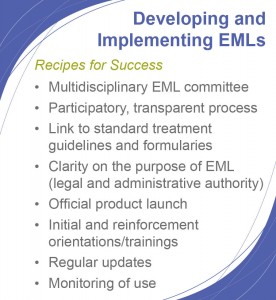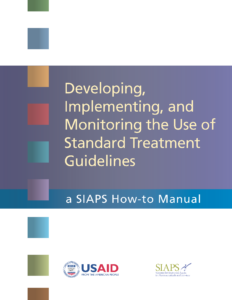Standard treatment guidelines (STGs) outline the recommended treatment options for a specific disease or medical condition (e.g., HIV and AIDS) or a range of medical conditions. Along with essential medicines lists (EMLs) and formularies, STGs help promote rational medicine use. Developed in close collaboration with end users through a consultative and consensus-building process, STGs can help standardize and optimize patient care. They also help simplify medicine supply, treatment decisions, trainings, and reimbursements.
SIAPS and its predecessor projects provided technical assistance to 19 countries throughout Africa, Asia, Europe, and Central and South America to support the development, revision, dissemination, implementation, training, and monitoring of STGs. In South Africa, for example, SIAPS worked with national stakeholders in the development of an electronic application that allows physicians and other health care providers to access the STGs, along with the EML, from a smartphone.
SIAPS also published a guidance document to support the development, revision, and implementation of STGs, particularly in low- and middle-income country settings.
To be successful, STGs require an evidence-based, transparent, and participatory development process as well as an effective and ongoing implementation strategy. The implementation of STGs requires a multifaceted approach, including educational outreach, interactive education workshops, auditing and feedback, influence of opinion leaders, and integration into pre-service trainings. The SIAPS approach to ensuring a systematic process of developing and implementing STGs hinged on building the capacity of national stakeholders to:
- Establish an STG development and implementation committee
- Develop an overall plan for guidelines
- Identify the diseases that the STGs will cover
- Determine appropriate treatment options
- Determine what information should be included in the STGs
- Draft the STGs for comment and pilot testing
- Finalize, publish, disseminate, and implement the STGs
- Monitor the use of the STGs and treatment outcomes
- Revise and update the STGs
Essential Medicines Lists
The careful selection and implementat ion of a limited list of essential medicines is a proven, effective intervention that enhances access to and rational use of pharmaceuticals, improves quality of care, and supports cost-effective use of resources. The essential medicines concept has become an established approach in the field of international public health and is supported by governments and health care providers around the world. To date, at least 156 countries have adopted national EMLs.
ion of a limited list of essential medicines is a proven, effective intervention that enhances access to and rational use of pharmaceuticals, improves quality of care, and supports cost-effective use of resources. The essential medicines concept has become an established approach in the field of international public health and is supported by governments and health care providers around the world. To date, at least 156 countries have adopted national EMLs.
With funding from USAID, SIAPS and its predecessor programs provided technical assistance to 13 countries to help develop, revise, disseminate, and/or provide orientation and training on EMLs. The countries supported include the Democratic Republic of the Congo, Ethiopia, Ghana, Kenya, Lesotho, Liberia, Malawi, Namibia, Rwanda, Senegal, South Africa, Swaziland, and Zambia.
On the basis of guidance from WHO, the SIAPS approach was to assist in-country stakeholders in following an established series of steps to develop or revise an EML:
Step 1: Develop working principles for the development or revision of the EML
Step 2: Choose members to form a multidisciplinary expert committee
Step 3: Initiate activities and develop explicit policies on medicine selection
Step 4: Establish a program for revisions, dissemination, and training on the EML
Step 5: Develop a monitoring component for the EML
Effectively developed and implemented EMLs improve medicine access and use, streamline procurement activities, minimize institutional costs, and optimize patient care.
Click here to read the SIAPS flyer on EMLs.


